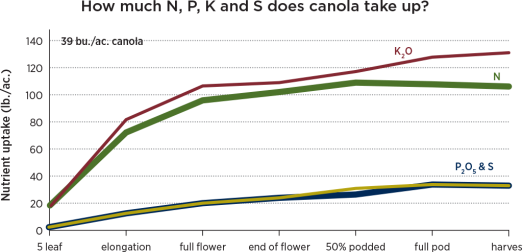Top dress if deficiencies are likely
Key practice: In Western Canada where the growing season is short, the ideal practice is to apply all fertilizer at the time of seeding. However, if shortages are expected or crops are showing deficiencies, soil-applied applications of nitrogen or sulphur fertilizer after emergence will likely provide an economic benefit.
Key research: Guy Lafond, Agriculture and Agri-Food Canada (AAFC). “Post Emergent Options for N Fertilization in Western Canada for Wheat and Canola” Manitoba Agronomists Conference proceedings, 2004, pp. 35-40.
S.S. Malhi, AAFC. “Restoring canola yield by applying suphur fertilizer during the growing season,” Lee, D.W. (Ed.), Agrium Symposium: Sulfur Fertility and Fertilizers, Agrium New Products R & D, Calgary, pp. 51-55.
Spring applied fertilizer, ideally applied at the time of seeding in a one-pass system, is generally considered the most timely and economical for Western Canada. Cindy Grant, research scientist with Agriculture and Agri-Food Canada (AAFC) in Brandon, MB, tested various nitrogen products and application timings and found that urea applied at the time of seeding achieved yields equal to or better than the same rates applied in a split application (some at seeding, some as an in-season top dress.) In a study titled “Post Emergent Options for N Fertilization in Western Canada for Wheat and Canola,” AAFC research scientist Guy Lafond concluded that, when moisture is adequate at seeding, the best practice is to apply all fertilizer at the time of seeding rather than use a split application with some at seeding and the rest added as a top dress.
However, over the years Lafond and other researchers have discovered some cases where top dressing does help. For canola, nitrogen and sulphur are the only two nutrients likely to provide a return on investment when applied as a top dress. It can make economic sense to top dress if:
- Growing conditions improve after seeding. If conditions were too wet or too dry at the time of seeding, growers may have cut back fertilizer rates in response to lower yield projections.
If conditions improve in June and a good stand emerges, growers may see a yield benefit from splitting the recommended rate, applying some
at seeding and some as a top dress. - Saturated soils impede good seed placement. This expands on the previous point. When the only choices to get canola seeded are mudding in or broadcast, cutting back nitrogen rates at seeding may be a good practice to reduce nutrient losses and to assess stand establishment.
If the crop becomes well established, an investment in more nitrogen fertilizer would be warranted. - High losses are likely to have occurred. Wet soil conditions can accelerate nitrogen losses through leaching and denitrification and sulphur losses through leaching. Fields may need a top up to reach their yield potential, but make sure canola survived the wet conditions before investing in the fertilizer.
- The crop is showing signs of deficiency. Nitrogen deficiency symptoms first show up in older leaves as pale green to yellow colouring, and sometimes purpling. Tissue analysis may confirm these observations, but be sure to follow lab rules for sampling. Turnaround time is another hurdle. Results may not come back in time to take action. As an alternative, growers or agronomists could do a small experi-
ment by spreading fertilizer on the surface and watering it in to see how plants respond. A small patch could be done by hand. If the plants in the patch green up, this suggests a nitrogen deficiency. - A grower cannot efficiently place all the fertilizer needed through the seeding tool. Some growers will address this with a top dress application of nitrogen after crop emergence.
- In cases of poor root growth. Plants may be able to reach leached nitrogen later in the season as their root systems fully develop, but canola in fields with excess moisture may not develop the root system to reach that far. If roots have been growing to the side and there is no dominant taproot, then the taproot is unlikely to develop fully. Lateral roots may start to turn downward as the top layer dries, but they may not have the reach of a good taproot. In this case, a top dress of nitrogen may help the crop — as long as good growing conditions have returned, improving the potential return on that nitrogen investment.

The ideal timing for an in crop application is before crop uptake starts to peak. Nitrogen uptake in canola rises rapidly after the five-leaf stage, as shown in the graph, while sulphur uptake increases more gradually over the season. Therefore, a nitrogen top dress should ideally occur before the five-leaf stage of the crop. This allows time for rainfall to move fertilizer into the root zone, making it available before the peak uptake period begins. Sulphur can be top dressed any time before peak flowering, although the earlier the better.
Efficient products for in crop application are urea (dry) and UAN (liquid) for nitrogen, and ammonium sulphate for sulphur.




